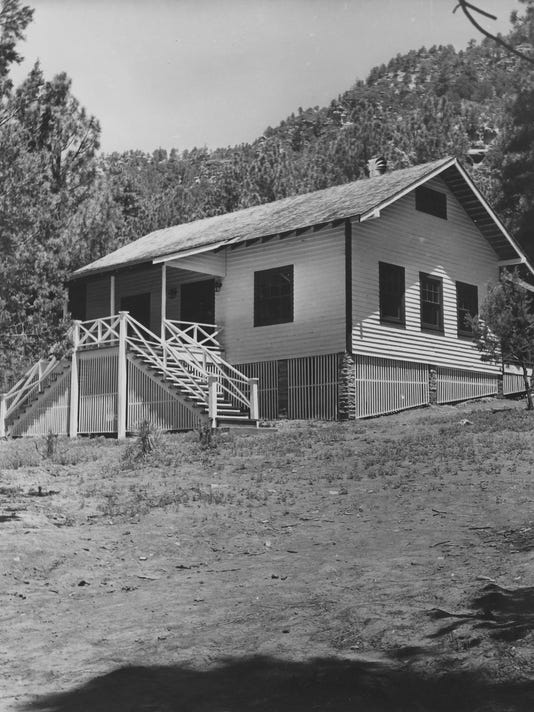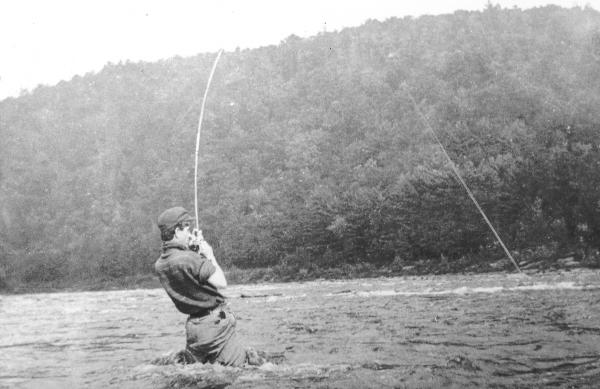Inveterate angler Zane Grey, writer of highly popular Western fiction, first visited Oregon in 1919 to fish the waters of the Rogue River and Crater Lake. He returned to the Rogue throughout the 1920s, turning his 1925 drift-boat expedition down the length of the lower Rogue into a chapter of his Tales of Fresh Water Fishing (1928). The trip also inspired his 1929 novel Rogue River Feud, which traded wild mustangs on the range for drift boats in whitewater rapids and the usual rapacious cattle baron for a villainous salmon-packing magnate (loosely based on R. D. Hume). Grey eventually became less enchanted with the Rogue as it became increasingly fished. By the mid-1930s, the North
Umpqua River had become Grey’s favorite Oregon stream.
Zane Grey helped popularize fly fishing for salmon and steehead in the Far West, and his writings helped give the Rogue and Umpqua their national reputations as preeminent steelhead-trout streams. He promoted conservation in many of his writings, condemning the Rogue’s salmon hatcheries as inevitably leading to “quantity over quality” and promoting judicious sport fishing at a time when most anglers proudly posed with huge strings of trout. To Grey, rural Oregon fishermen were wasteful rustics. For their part, local residents later recalled Grey as an elitist “dude.”
Born and raised in Zanesville, Ohio (named for his ancestors), Grey graduated from the University of Pennsylvania in 1896 with a degree in dentistry, and opened a practice in New York City. In 1912, he wrote his third Western, the phenomenally popular Riders of the Purple Sage. That novel was followed by a long string of successes, and Grey became one of the best-selling novelists of the twentieth century. Critics were not as kind to him as readers, however, and some dismissed him as "The Writer of the Purple Prose" because of his formulaic, florid style. In spite of Grey's critics, Hollywood converted nearly fifty of his novels into films, the most of any Western author.
In 1918, Grey (by then wealthy from his writing career) purchased a mansion outside Los Angeles, California, where he lived for the remainder of his life. Grey’s fishing cabin at Winkle Bar, in the still-remote lower Rogue River canyon, remains a favorite stopping point for groups of whitewater boaters. Long privately held, his property on Winkle Bar was purchased by the Trust for Public Land, which in 2008 transferred it to the U.S. Bureau of Land Management, thereby guaranteeing public access and providing for long-term preservation of Grey's historic cabin.
Written by: Jeff LaLande (http://www.oregonencyclopedia.org/entry/view/zane_grey_1872_1939_/)
Best-selling Western author Zane Grey built a one-room cabin on the Rogue River in southern Oregon 1926. He used it as his retreat for writing, and also to indulge his other passion: fishing for the river's salmon and steelhead trout. Today the Rogue is a national Wild and Scenic River, and Grey's one-room cabin remains, surrounded by Bureau of Land Management (BLM) wilderness.
 Una foto de 1964 muestra la cabaña de Zane Grey antes de que fuera destruida en el Dude Fire de 1990.
Una foto de 1964 muestra la cabaña de Zane Grey antes de que fuera destruida en el Dude Fire de 1990.
Famous western author Zane Grey shoots the Rogue River Rapids at Lower Black Bar during a 1925 fishing excursion. He later memorialized the Oregon wilderness in his novel Rogue River Feud.
“It was a river at its birth; and it glided away through the Oregon forest, with hurrying momentum, as if eager to begin the long leap down through the Siskiyous. The giant firs shaded it; the deer drank from it; the little black-backed trout rose greedily to floating floes.” —from Rogue River Feud
“He had a leathery, weather-beaten face, homely and hard, unshaven and dirty, yet despite these features and the unmistakable imprint of the bottle, somehow far from revolting. Perhaps that was due to the large, wide-open, questioning blue."
In September 1926, Zane Grey built a rustic cabin on the site with the help of local river guide Claude Bardon. It took the men three months to build the one-room log cabin, using timber from the property. Zane Grey’s cabin was built the same way that old miners had built their cabins for hundreds of years.
“And the river glided on in an endless solitude, its eternal song, low and musical, near at hand, droning sweet melody from the rapid at the bend, and filling the distant drowsy aire with its soft thunder.”
Zane Grey fishing in the Delaware River near Lackawaxen, PA, circa 1910.
Courtesy of the Upper Delaware Scenic and Recreational River, National Park Service, Zane Grey Museum











No hay comentarios:
Publicar un comentario